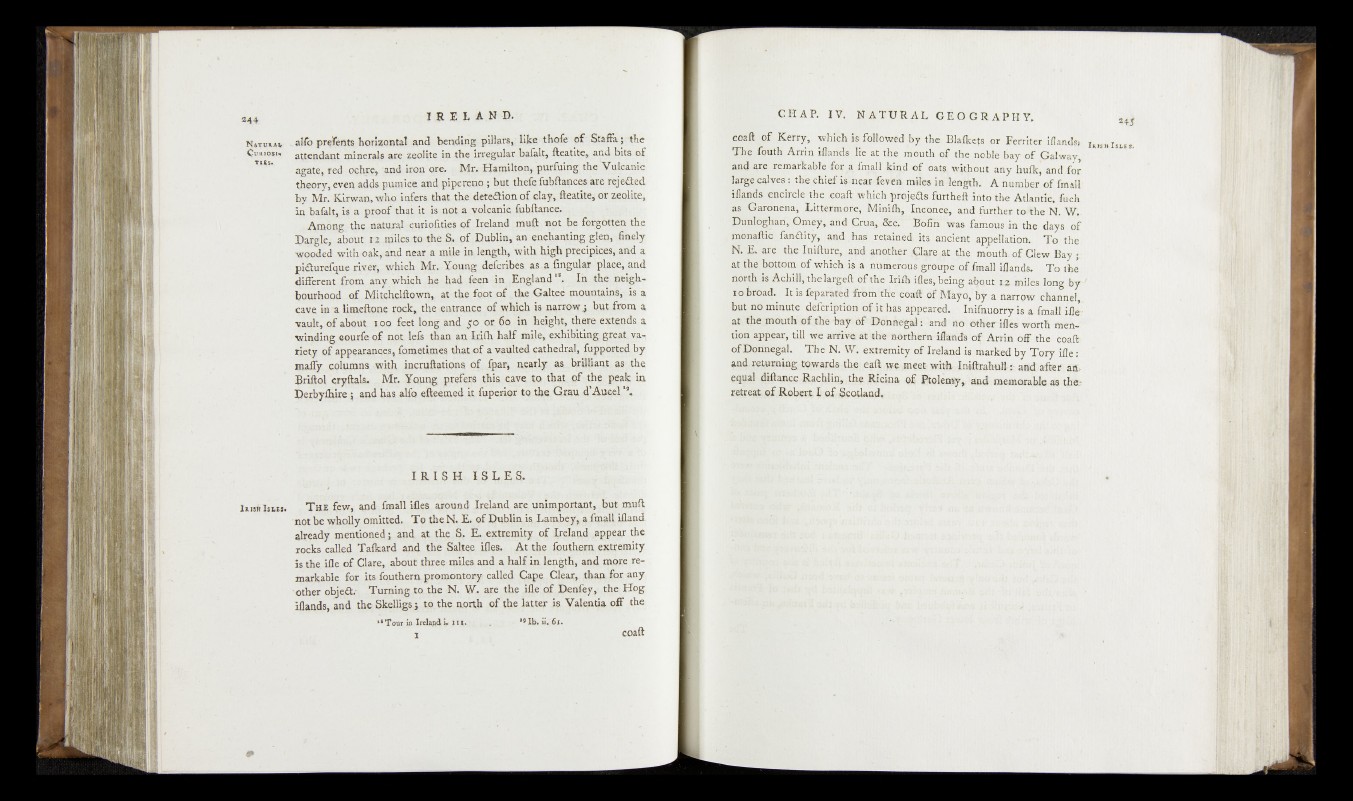
«44
N atural
Çurnasi-!
' tirs.
I rish I sles.
alfa prefentg horizontal and benjding pillars, like thafe o f Staflà ; the
attendant minerals are zeolite in the irregular bafalt, fteatite, and bit®, of
agate, fed ochre, 'and iron ore, Mr. Hamilton, purfuipg the Vnkanic
theory, even adds puto'CC and pipers,W > bnt theft fubftances are rçje&ed
by Mr. Kirwan, who infers thaï the detedion of clay, fteatite,' or zeolite,
in baftlt, it a proof that it is not a volcanic fuhftance. •
Among the natural euriofities of Ireland muft apt he forgotten the
Barglq, about 12 miles, to the S. of Dublin,; an enchanting glen, .finely
wooded with oak,-and near a mile in length, with high precipices, and a
pidurefque river, which Mr. Young deftribes as. a lingular place, and
different from any which fie had feen in England . ^ In the neighbourhood
of Mitehelftown, at the foot of the Galtee mountains, is a
cave in a limeftone rock, the entrance of which is narrowÿ but fmra a
vault, of about 100 feet long and 50. or. 69 in height, there extends a
winding eourfe of not left than an Irilh half miles, exhibiting. g|ç^|gan
rietjr of appearances, fomotimea that of a vaulted cathedral, fuppor-ted by
maffy columns with ineruftatipna of %ar, nearly as. hrilUant as the
Briftol cryftals, Mr. Young prefers this cave to that ©f the peak in
Derbyshire j and has alfo efteeraed it fuperior to the Qrau d’Aueel.,9.
I R I S H IS L E S .
T h e few, and finall ifles around Ireland are. unimportant, but muft
not be wholly omitted. To theN, E. pf Dublin is. Eambey,^ ftpaliifland.
already mentioned 4 and. at the S. E. extremity of Ireland appear the
rocks called Taflsard and the Saltee. ifles> At the fo.uftmra extremity
is the ifle of Clare, about three miles and a half in length, and more remarkable
for its fimthern promontory called Cape Clear, than for any
other objedt- Turning to, the N. W . are the .ifte qf Denfey,' jthe H©g
illaads, and the Skelligs j to. the north of the latter is. Valentia off the
•'Tour in Irelandp ll.n . . lb. ii. 61.
I coaft
coaft of Kerry, whil^-is' followed by the Rlalkefs or Ferriter iflandsj
The foüth Arrin iflaiids lie^'t the mouth of the noble bay of Galway,
and are remarkable f ^ a f tr ^U kiyd of oat£ without any hulk’ and for.
large calves': the.cjiftf is^hearfevert miles in length. A number, of fmall
ifands||eiicitcle the coaft whioh^rpiftifts ftjrtheft into the Atlantic, fuch
as |£arbnena, Immnee, and further to^the N. W.
Dunlogbari, ©mCy, inds^na;,. &c." ' Boffn was famous in the days of
mongjftic Jkn^ity, and , has E e ta i^ rife armerjt appellation. To the
N. E . are - the lulfturc, .ap'd p o th e r ^sp-e^at -the mouth, of-Clew Bay }-
at tfie bottom of which is a nu.tnerou*Jg t ^ 4 f®f lmall iflands. To the.
north ds Achrfj^W t e O f è f,th-e I^iih ifles* being .afeadt L2 miles long by
1 abroad.^ It is fepariflfl from fffe'mokft öf M a y o /ly a narrow channel*
but nt> minute deferiptfc® pfijt has appeared^1 Inh^uorry. is a fmall iüs-
at. the ..mouth of the hay o f Eronhegah and no other ifles worth meA-
rion appear, till we arrive at the northern ifftada o f Arrin off the- coaft
of Dorinegal. .The N'. W. extremity of Ireland is marked by Tory ifle:
and: resuming towards thq j efft ty* .meet- with Initrah-ult ï and after an*
equal dtftance Rachliu, the. Ricina ©f Ptolemy* and memorable as the;
retreat of Robert I of Scotland,
Irish I sles.